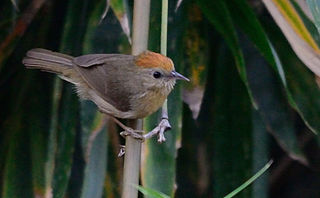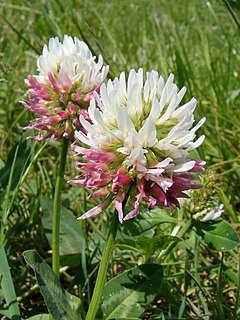
Black band disease is a coral disease in which corals develop a black band. It is characterized by complete tissue degradation due to a pathogenic microbial consortium. The mat is present between apparently healthy coral tissue and freshly exposed coral skeleton.
In zoological nomenclature, a nomen dubium is a scientific name that is of unknown or doubtful application.

Spirostomum is a genus of free-living ciliate protists, belonging to the class Heterotrichea. Species of Spirostomum are found in both salt and fresh water. All are elongated, flexible and highly contractile. Although unicellular, members of some species can grow as long as 4 mm (0.16 in).

The buff-chested babbler is a species of bird in the Old World babbler family. It is found in south-eastern Asia from the eastern Himalayas to southern Laos.
Eriophyllum ambiguum is a species of flowering plant in the aster family known by the common name beautiful woolly sunflower. It is native to the deserts and adjacent hills of southern and eastern California, northwestern Arizona, and southern Nevada.

Yolla Bolly bedstraw is a species of plant in the family Rubiaceae, native to British Columbia, northern California and southeastern Oregon.

Lomatium ambiguum, also known as Wyeth biscuitroot, is a perennial herb of the family Apiaceae that grows in the northwestern United States and into British Columbia in dry areas. The leaves are divided into many blades, and stems can be slightly purple and are 6–24 cm tall. Yellow flowers in compound umbels appear from late April to June.

Parablechnum ambiguum, synonym Blechnum ambiguum, is a species of fern in the family Blechnaceae. growing on wet rocks in eastern Australia, often seen near waterfalls. It is common around Sydney.

Sympetrum ambiguum, the blue-faced meadowhawk, is a dragonfly of the family Libellulidae.
Onchidium ambiguum is a species of air-breathing sea slug, a shell-less marine pulmonate gastropod mollusk in the family Onchidiidae.
Dipodium ambiguum is an orchid species that is endemic in Borneo. The species was formally described in 2017 by Peter O'Byrne, Linus Gokusing and Anthony Lamb. The description was published in Volume 19 of the Malesian Orchid Journal, edited by André Schuiteman.
Eotaphrosphys is an extinct genus of bothremydid pleurodiran turtle that was discovered in the Mont Aime Formation, France. Originally assigned to the genus "Tretosternum", it consists exclusively of type species E. ambiguum.
Tapinoma ambiguum is a species of ant belonging to the family Formicidae.
Laevidentalium is a genus of molluscs belonging to the family Laevidentaliidae.

Susanna Wood is a New Zealand scientist whose research focuses on understanding, protecting and restoring New Zealand's freshwater environments. One of her particular areas of expertise is the ecology, toxin production, and impacts of toxic freshwater cyanobacteria in lakes and rivers. Wood is active in advocating for the incorporation of DNA-based tools such as metabarcoding, genomics and metagenomics for characterising and understanding aquatic ecosystems and investigating the climate and anthropogenic drivers of water quality change in New Zealand lakes. She has consulted for government departments and regional authorities and co-leads a nationwide programme Lakes380 that aims to obtain an overview of the health of New Zealand's lakes using paleoenvironmental reconstructions. Wood is a senior scientist at the Cawthron Institute.
Pteronema is a genus of hydrozoans belonging to the monotypic family Pteronemidae.

Trifolium ambiguum, the kura clover or Caucasian clover, is a species of flowering plant in the family Fabaceae. It is native to Ukraine, Crimea, south European Russia, the northern Caucasus, Turkey, Iraq, and Iran, and has been introduced to New South Wales. Planted for forage, once established it is tolerant of close grazing, and is also useful for honey production.

Phormidium is a genus of cyanobacteria in the family Oscillatoriaceae.
Phormidium aerugineo-caeruleum is a species of cyanobacteria in the genus Phormidium.
Phormidium allorgei is a species of cyanobacteria in the genus Phormidium.









